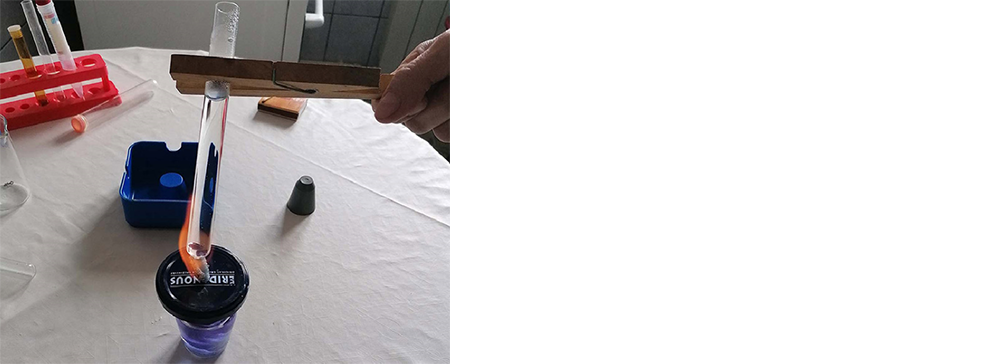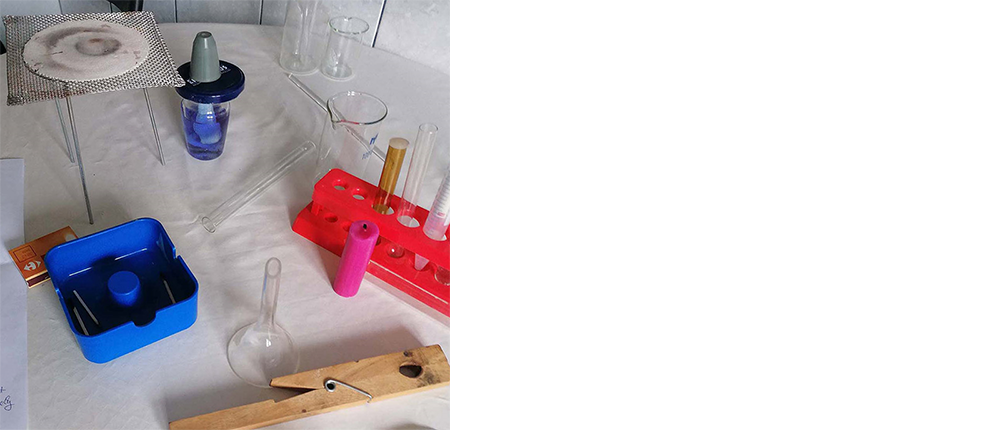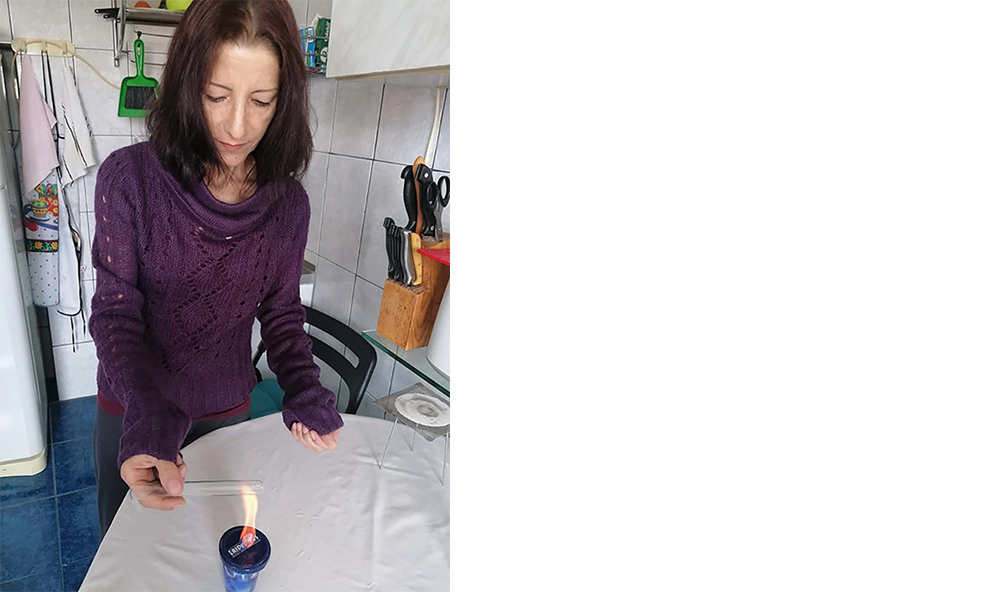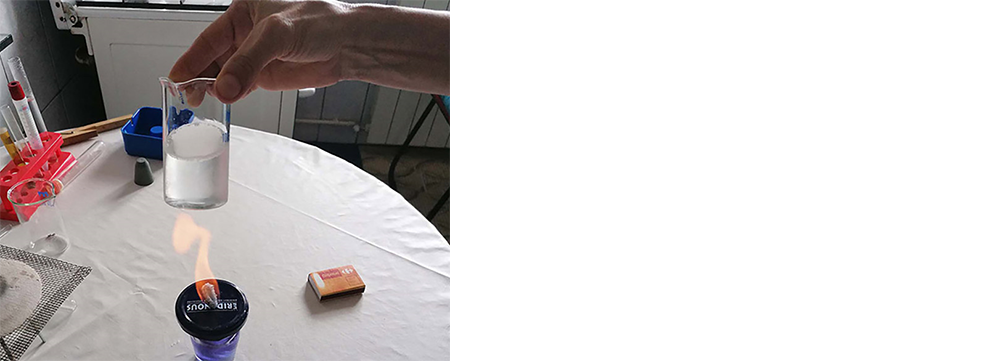Labor protection rules.
A. Protective measures to prevent accidents.
A.1.1. Conducting experiments.
Experiments are performed only under the guidance of the teacher, strictly following his instructions.
A.1.2. Heating sources and body heating.
👀 Experiment: How can I make a spirit bottle? Correct lighting and extinguishing of the spirit.
🔥 Warning! This experiment is performed only in the presence of an adult!
🔥 Warning! When working with fire sources make sure to keep your hair tight and don't wear clothes with wide sleeves!
-
Heating sources must be used with care.
-
Lighting the spirit bottle (filled only with sanitary alcohol) is done only with a match stick and extinguishing it is done only by covering the flame with the lid of the spirit bottle.
👀 Experiment: How can I heat a wire in a flame without burning my fingers?
🔥 Warning! This experiment is performed only in the presence of an adult!
🔥 Warning! When working with fire sources make sure to keep your hair tight and don't wear clothes with wide sleeves!
- A body is heated by holding it with metal tongs in the upper part of the flame, where the temperature is highest.
👀 Experiment: How can I heat a glass of liquid with a spirit bottle?
🔥 Warning! This experiment is performed only in the presence of an adult!
🔥 Warning! When working with fire sources make sure to keep your hair tight and don't wear clothes with wide sleeves!
- When heating liquids in glass vessels, the vessel is placed on a metal sieve with asbestos.
👀 Experiment: How can I heat a flammable substance without causing a fire?
🔥 Warning! This experiment is performed only in the presence of an adult!
🔥 Warning! When working with fire sources make sure to keep your hair tight and don't wear clothes with wide sleeves!
🔥 Warning! Alcohol, naphthalene and acetone are flammable substances and stay away from sources of fire when working with them!
- Flammable substances (naphthalene, acetone, alcohol, etc.) are only heated in a water bath.
👀 Experiment: How can I heat a liquid in a test tube without burning myself?
🔥 Warning! This experiment is performed only in the presence of an adult!
🔥 Warning! When working with fire sources make sure to keep your hair tight and don't wear clothes with wide sleeves!
- Wooden tongs are used to heat the test tube; the mouth of the test tube must not be directed at any person. In order not to break rotates the test tube in the flame!
🔥 Warning!
-
Overheating of electrical wires (detected by the smell of heated rubber) also presents a risk of fire, in which case the current is immediately interrupted.
-
To ensure protection against fires, it is necessary to find the following in the laboratory: water, fire extinguishers, sand, blankets, asbestos, tiles.
-
The flame of any liquid (flammable, burning oil, etc.) or electrical fire, do not extinguish with water, but cover with an insulator to avoid contact with air. If a person's clothes have caught fire, he immediately wraps himself in a blanket.
-
For example, when you fry potatoes and put too many potatoes or too much oil in the pan, the oil comes out of the pan and catches fire. How to proceed: first turn off the stove and cover the pan with a lid. If you don't have a lid, cover with a dry towel or blanket. It is forbidden to throw water over the hot oil as the hot oil would jump out of the pan and cause serious burns.
-
The handling of flammable solvents (metallic sodium and potassium kept under oil, carbon disulphide, alcohol, ether, benzene, chloroform, acetone, etc.) is done under the niche and with the heating sources turned off.
-
The heating of flammable solvents is not done with a direct flame, but only in a water or sand bath. Any fire that starts is extinguished with sand, a blanket or a fire extinguisher.
A.1.3. Handling of chemical substances.
Warning!
-
The handling of chemical substances begins with a first condition, namely knowing the main properties of the respective substance, from the point of view of work safety: toxic, explosive, flammable, caustic, irritant, oxidizing (indicated with the help of labels).
-
Small amounts of substance are used.
👀 Experiment: Magic wand
- Stirring a liquid is done with the wand in circular motions without touching the walls.
👀 Experiment: Do not taste or touch the chemical substances!
🔥 Warning! Do not taste or touch the substances!
- It is not allowed to taste chemical substances, to mix substances at random and to touch them with the hand.
Warning!
-
During the experiments, clothes with loose sleeves will not be worn and the hair will be tied back.
-
When conducting an experiment, the head is held slightly back so that the face is further away from the experimental setup.
-
To have a solution of sulfuric acid, pour the acid over the water, drop by drop, always stirring.
-
Flammable substances are stored in well-closed bottles, in the cold and in the dark, away from heating sources.
👀 Experiment: How to smell the chemicals.
🔥 Warning! Do not directly smell the chemicals!
- Smelling a substance is done indirectly, bringing the vapors to the nose with the hand.
Warning!
• To protect the eyes in the case of transvasation of caustic liquids (concentrated acids or bases), when performing experiments with metallic sodium and potassium, when processing glass, when crushing solid substances (alkalis), when performing explosive experiments, it is necessary to wear protective glasses.
• Maintaining order and cleanliness on laboratory tables.
• Use of crockery and equipment in perfect and clean condition.
👀 Experiment: Correct handling of sharp objects!
🔥 Warning! Be careful when working with sharp objects!
- When working with sharp objects, they do not point towards us or other people.
Warning!
-
To make electrical circuits, students will use electrical batteries. They are not allowed to use the sockets.
-
After finishing the experiments, tidy up and wash your hands.
-
Playing in the laboratory or lifting from the bench is totally prohibited.
-
During the experimental hours, the consumption of drinks or food is prohibited.
-
Corrosive reagents (alkaline hydroxides, concentrated acids, concentrated ammonia solution, perhydrol 30%, bromine, etc.) will be transferred into the test tube with the help of the pipette.
-
Work with toxic substances with special care.
-
The remains of dangerous substances (alkaline metals, phosphorus, concentrated acids and bases, flammable liquids) will not be thrown down the drain, because they can cause explosions and corrosion and will be neutralized.
-
The handling of explosive substances (nitroderivatives, chlorates, perchlorates, peroxides, perchloric acid, etc.) must be done with great care, without hitting and without heating to the point of decomposition.
A.1.4. International warning symbols.
1. FLAMMABLE SUBSTANCE
Symbol:

-
Ignition occurs very easily in contact with an energy source (flame, spark).
-
Keep away from flames, sparks or any heat source.
2. EXPLOSIVE SUBSTANCE
Symbol:

-
Presents an explosion hazard (butane gas, propane, explosive materials, fireworks, etc.).
-
Avoid heat, shock, friction and sparks.
3. POISONOUS SUBSTANCE
Symbol:

-
Can cause serious injury or even death through inhalation, ingestion or skin penetration (insecticides, fertilizers, herbicides, etc.).
-
Avoid any contact with the body.
4. SEVERE IRRITANT SUBSTANCE
Symbol:

-
May be fatal if swallowed or enters the respiratory tract. Can cause organ damage (turpentine, gasoline, kerosene, etc.). In case of inhalation: if breathing is difficult, take the victim to fresh air and keep him at rest in a comfortable position for breathing.
-
Any contact with the skin, eyes and inhalation of vapors shall be avoided.
5. SLIGHTLY IRRITANT SUBSTANCE
Symbol:

-
May cause skin, eye or respiratory irritation. Their absorption can lead to minor injuries (dishwashing powder, chlorine, etc.).
-
Any contact with the skin, eyes and inhalation of vapors shall be avoided.
6. CORROSIVE SUBSTANCE
Symbol:

-
Product that by simple contact or swallowing can burn or destroy tissues (skin or mucous membrane) - concentrated chlorine, caustic soda, acids, etc.
-
Avoid inhalation of vapors or contact with skin, eyes and clothes.
7. OXIDIZING SUBSTANCE
Symbol:

-
Product that favors the ignition of combustible materials, maintenance of combustion (effervescent chlorine tablets, O2).
-
Avoid any contact with flammable substances.
A.1.5. Apply what you have learned about labor protection rules in the laboratory.
📝 Homework
1. Look for the warning symbols on the labels of the different products you have at home (Sprays, Cleaning products, Pipe unclogging products and group them according to these symbols).
📝 Homework
2. Watch the following images and find out which rules were broken and which would endanger our lives:
2.1. .....................................................

2.2. .....................................................

2.3. .....................................................

2.4. .....................................................

2.5. .....................................................

2.6. .....................................................

2.7. .....................................................
